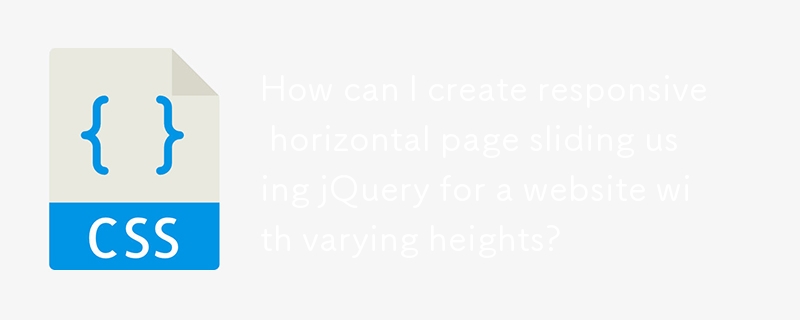 Web Front-end
Web Front-end
 CSS Tutorial
CSS Tutorial
 How can I create responsive horizontal page sliding using jQuery for a website with varying heights?
How can I create responsive horizontal page sliding using jQuery for a website with varying heights?
How can I create responsive horizontal page sliding using jQuery for a website with varying heights?
Oct 29, 2024 pm 01:10 PM
Horizontal Responsive Page Sliding
To design a responsive page navigation similar to the provided image, consider the following jQuery solution:
- Calculate Dimensions: Determine the number of slides, set the wrapper width, and set each slide's width accordingly.
- Slide Animation: Bind a click event to navigation links that animates the wrapper's left-margin to reveal the corresponding slide.
- Active Link: Toggle the "selected" class for the clicked link to highlight the active page.
This approach ensures that the navigation adapts to screen size and handles pages with varying heights, eliminating gaps. Additionally, it utilizes a single menu occurrence to minimize markup and supports a dynamic number of slides.
<code class="js">$(document).ready(function () {
var slideNum = $('.page').length,
wrapperWidth = 100 * slideNum,
slideWidth = 100 / slideNum;
$('.wrapper').width(wrapperWidth + '%');
$('.page').width(slideWidth + '%');
$('a.scrollitem').click(function () {
$('a.scrollitem').removeClass('selected');
$(this).addClass('selected');
var slideNumber = $($(this).attr('href')).index('.page'),
margin = slideNumber * -100 + '%';
$('.wrapper').animate({
marginLeft: margin
}, 1000);
return false;
});
});</code>
<code class="css">html,
body {
height: 100%;
margin: 0;
overflow-x: hidden;
position: relative;
}
nav {
position: absolute;
top: 0;
left: 0;
height: 30px;
}
.wrapper {
height: 100%;
background: #263729;
}
.page {
float: left;
background: #992213;
min-height: 100%;
padding-top: 30px;
}
#page-1 {
background: #0C717A;
}
#page-2 {
background: #009900;
}
#page-3 {
background: #0000FF;
}
a {
color: #FFF;
}
a.selected {
color: red;
}
.simulate {
height: 2000px;
}</code>
<code class="html"><script src="https://ajax.googleapis.com/ajax/libs/jquery/1.11.0/jquery.min.js"></script>
<div class="wrapper">
<nav>
<a href="#page-1" class="scrollitem selected">page 1</a>
<a href="#page-2" class="scrollitem">page 2</a>
<a href="#page-3" class="scrollitem">page 3</a>
</nav>
<div id="page-1" class="page">
<h3>page 1</h3>
<div class="simulate">Simulated content heigher than 100%</div>
</div>
<div id="page-2" class="page">
<h3>page 2</h3>
<div class="simulate">Simulated content heigher than 100%</div>
</div>
<div id="page-3" class="page">
<h3>page 3</h3>
<div class="simulate">Simulated content heigher than 100%</div>
</div>
</div></code>The above is the detailed content of How can I create responsive horizontal page sliding using jQuery for a website with varying heights?. For more information, please follow other related articles on the PHP Chinese website!

Hot AI Tools

Undress AI Tool
Undress images for free

Undresser.AI Undress
AI-powered app for creating realistic nude photos

AI Clothes Remover
Online AI tool for removing clothes from photos.

Clothoff.io
AI clothes remover

Video Face Swap
Swap faces in any video effortlessly with our completely free AI face swap tool!

Hot Article

Hot Tools

Notepad++7.3.1
Easy-to-use and free code editor

SublimeText3 Chinese version
Chinese version, very easy to use

Zend Studio 13.0.1
Powerful PHP integrated development environment

Dreamweaver CS6
Visual web development tools

SublimeText3 Mac version
God-level code editing software (SublimeText3)

Hot Topics
 What is 'render-blocking CSS'?
Jun 24, 2025 am 12:42 AM
What is 'render-blocking CSS'?
Jun 24, 2025 am 12:42 AM
CSS blocks page rendering because browsers view inline and external CSS as key resources by default, especially with imported stylesheets, header large amounts of inline CSS, and unoptimized media query styles. 1. Extract critical CSS and embed it into HTML; 2. Delay loading non-critical CSS through JavaScript; 3. Use media attributes to optimize loading such as print styles; 4. Compress and merge CSS to reduce requests. It is recommended to use tools to extract key CSS, combine rel="preload" asynchronous loading, and use media delayed loading reasonably to avoid excessive splitting and complex script control.
 External vs. Internal CSS: What's the Best Approach?
Jun 20, 2025 am 12:45 AM
External vs. Internal CSS: What's the Best Approach?
Jun 20, 2025 am 12:45 AM
ThebestapproachforCSSdependsontheproject'sspecificneeds.Forlargerprojects,externalCSSisbetterduetomaintainabilityandreusability;forsmallerprojectsorsingle-pageapplications,internalCSSmightbemoresuitable.It'scrucialtobalanceprojectsize,performanceneed
 Does my CSS must be on lower case?
Jun 19, 2025 am 12:29 AM
Does my CSS must be on lower case?
Jun 19, 2025 am 12:29 AM
No,CSSdoesnothavetobeinlowercase.However,usinglowercaseisrecommendedfor:1)Consistencyandreadability,2)Avoidingerrorsinrelatedtechnologies,3)Potentialperformancebenefits,and4)Improvedcollaborationwithinteams.
 CSS Case Sensitivity: Understanding What Matters
Jun 20, 2025 am 12:09 AM
CSS Case Sensitivity: Understanding What Matters
Jun 20, 2025 am 12:09 AM
CSSismostlycase-insensitive,butURLsandfontfamilynamesarecase-sensitive.1)Propertiesandvalueslikecolor:red;arenotcase-sensitive.2)URLsmustmatchtheserver'scase,e.g.,/images/Logo.png.3)Fontfamilynameslike'OpenSans'mustbeexact.
 What is Autoprefixer and how does it work?
Jul 02, 2025 am 01:15 AM
What is Autoprefixer and how does it work?
Jul 02, 2025 am 01:15 AM
Autoprefixer is a tool that automatically adds vendor prefixes to CSS attributes based on the target browser scope. 1. It solves the problem of manually maintaining prefixes with errors; 2. Work through the PostCSS plug-in form, parse CSS, analyze attributes that need to be prefixed, and generate code according to configuration; 3. The usage steps include installing plug-ins, setting browserslist, and enabling them in the build process; 4. Notes include not manually adding prefixes, keeping configuration updates, prefixes not all attributes, and it is recommended to use them with the preprocessor.
 What are CSS counters?
Jun 19, 2025 am 12:34 AM
What are CSS counters?
Jun 19, 2025 am 12:34 AM
CSScounterscanautomaticallynumbersectionsandlists.1)Usecounter-resettoinitialize,counter-incrementtoincrease,andcounter()orcounters()todisplayvalues.2)CombinewithJavaScriptfordynamiccontenttoensureaccurateupdates.
 CSS: When Does Case Matter (and When Doesn't)?
Jun 19, 2025 am 12:27 AM
CSS: When Does Case Matter (and When Doesn't)?
Jun 19, 2025 am 12:27 AM
In CSS, selector and attribute names are case-sensitive, while values, named colors, URLs, and custom attributes are case-sensitive. 1. The selector and attribute names are case-insensitive, such as background-color and background-Color are the same. 2. The hexadecimal color in the value is case-sensitive, but the named color is case-sensitive, such as red and Red is invalid. 3. URLs are case sensitive and may cause file loading problems. 4. Custom properties (variables) are case sensitive, and you need to pay attention to the consistency of case when using them.
 Case Sensitivity in CSS: Selectors, Properties, and Values Explained
Jun 19, 2025 am 12:38 AM
Case Sensitivity in CSS: Selectors, Properties, and Values Explained
Jun 19, 2025 am 12:38 AM
CSSselectorsandpropertynamesarecase-insensitive,whilevaluescanbecase-sensitivedependingoncontext.1)Selectorslike'div'and'DIV'areequivalent.2)Propertiessuchas'background-color'and'BACKGROUND-COLOR'aretreatedthesame.3)Valueslikecolornamesarecase-insens





